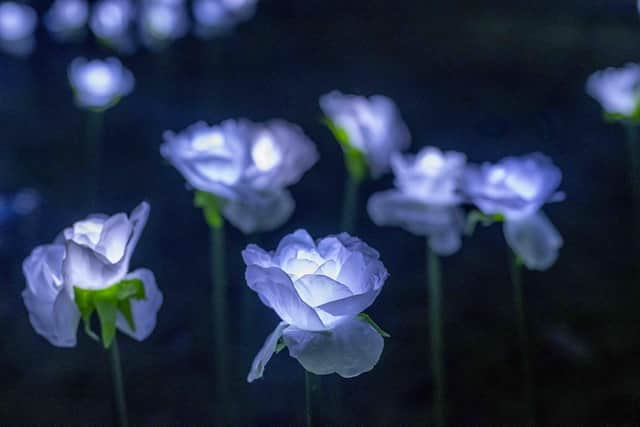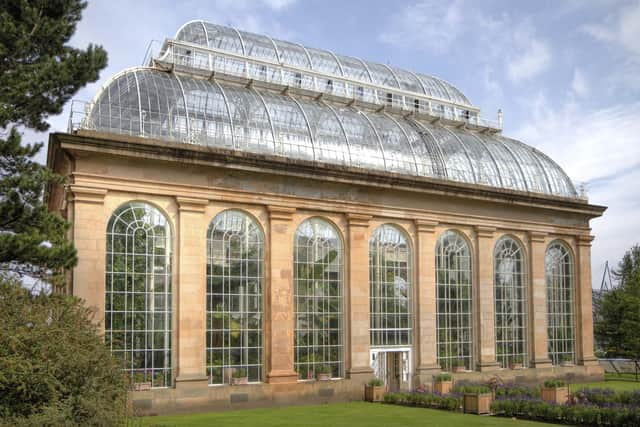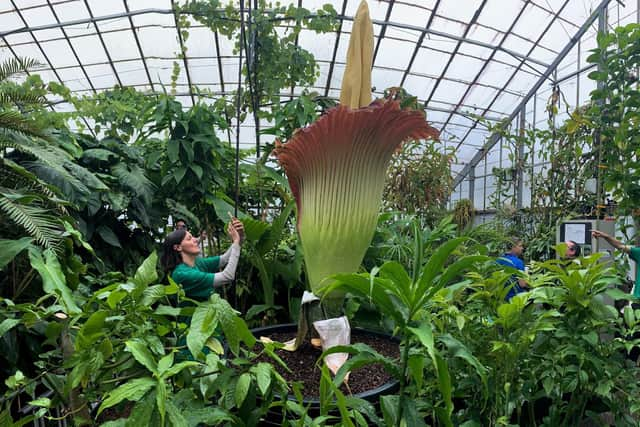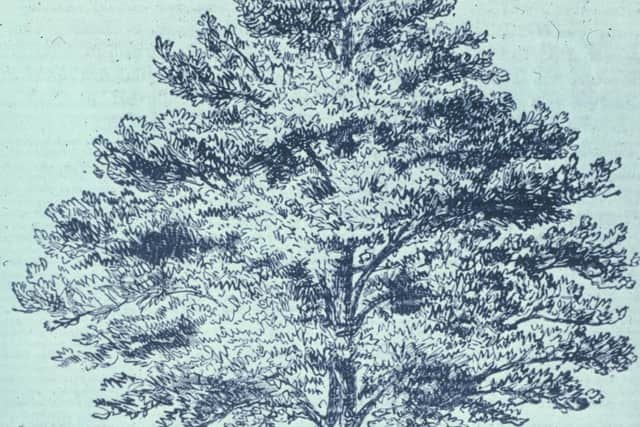Why the Royal Botanic Garden Edinburgh, founded to grow medicinal herbs, is more relevant than ever after 350 years
This spring, The Royal Botanic Garden Edinburgh (RBGE) will mark 200 years since opening the gates at its headquarters in the city’s Inverleith area.
However, its roots stretch much further back than that – more than 350 years – making it the second-oldest botanic garden in the UK, with a back story almost as colourful as the 13,500 plant species which grow within its boundaries.
Advertisement
Hide AdAdvertisement
Hide AdThe RBGE, granted a royal warrant in 1699, can claim to have played an important part in the careers of notable historical figures who studied botany there as part of their medical training at Edinburgh University.
Among them are Scottish doctor James Barry, who was born a woman but lived as a man and carved out a distinguished career as a surgeon in the British Army in the early 1800s.
Another is Sir Arthur Conan Doyle, author of the Sherlock Holmes mysteries, who drew on his knowledge of plants as poisons when writing his famous novels.
The Inverleith garden was also the site of a fatal plane crash during the Second World War, when a Spitfire came down after colliding with another aircraft.
Today, the gardens are popular attractions, with more than a million visitors each year, and their scientific work has probably never been more relevant.


“The inception of the Royal Botanic Garden Edinburgh 353 years ago was rooted in the profound recognition of the importance of plants to society,” said current regius keeper Simon Milne, only the 16th in the institution’s long history.
“This enduring belief remains at the heart of our present vision – a commitment to achieving a brighter future for plants, people and the planet.
“Plants stand as a cornerstone of our planet’s functionality, integral to humanity's future.”
ROOTS
Advertisement
Hide AdAdvertisement
Hide Ad

RBGE, nowadays popularly known as the Botanics, was set up during a turbulent age – in a Scotland impoverished by centuries of civil war and with Edinburgh itself still reeling from Oliver Cromwell’s invasion and its worst-ever bubonic plague outbreak.
It was founded in 1670 by Scottish doctors Andrew Balfour and Robert Sibbald as a physic garden, to supply fresh plants for medicinal prescriptions and teach botany to medical students.
Its original home was a small piece of ground, about the size of a tennis court, near the royal Palace of Holyroodhouse.
Sibbald later explained his inspiration for creating the garden, writing in his autobiography: “I resolved to make it part of my study to know those animals, vegetables, mineralls, metals and substances cast up by the sea, were found in this country, that might be of use in medicine, or other artes usefull to human lyfe.”


The garden quickly outgrew the first plot and, five years later, moved to a site adjoining a hospital on the banks of what was then the Nor’ Loch – where Waverley station now stands.
But the loch was later drained, engulfing the garden in mud and detritus and harming many of the plants.
Partly because of the damage but also to further expand the garden, it relocated to a third home in 1763 – a green field site outside the “polluted” city, on what would become Leith Walk.
But that would not be its final resting place.
The garden began the flit to its current home in 1820, taking more than three years to shift all the living material – including large mature trees.
Advertisement
Hide AdAdvertisement
Hide AdThe first public visitors were welcomed to the new 70-acre premises at Inverleith Row in spring 1824.


The garden continued to evolve.
Additions included the iconic Victorian palm houses, which are still in use today, as well as Botanic Cottage, simultaneously the oldest and newest building at the Inverleith site.
Originally the home of esteemed head gardener Dr John Hope, the cottage had also served as a classroom for botany students and as the main entrance to the garden at Leith Walk, where it remained for more than two centuries.
But time took its toll on the structure and it was earmarked for demolition in 2008.
However, that wasn’t the end of the road for the house.
Mediterranean diet: Could olive oil, lemons and tomatoes drop off the UK menu due to climate change?
Thanks to a community campaign to save it, the historical building was taken down stone by stone and rebuilt at Inverleith, with construction completed in 2016.
And it’s not just bricks and mortar which have endured through the ages.
RGBE gardeners are still caring for a palm tree collected in Bermuda around 1790 and which survived the big move from Leith Walk to Inverleith.
It is the oldest plant in the living collection and can still be seen growing in the tropical palm house.
Advertisement
Hide AdAdvertisement
Hide AdEven older is a preserved myrtle, picked in South Africa in 1697 and saved for posterity in the RBGE’s extensive herbarium.
But the most ancient of all is a tree which grew in a prehistoric swamp forest around 340 million years ago – though technically the 10.5m-long petrified trunk, the largest plant fossil found in Scotland, is an exhibit rather than a scientific specimen.
BRANCHES
From humble beginnings, RBGE has become a global leader in plant science and horticulture as well as an international centre for education, providing expertise on the biggest existential challenges facing the planet – climate change and loss of biodiversity.
It now operates four sites across Scotland: The Edinburgh headquarters plus regional gardens at Benmore in Argyll; Dawyck in the Borders; Logan, in Dumfries and Galloway – each with different topography, soils and climate, allowing a wide range of plants to thrive.
The organisation offers a diverse range of formal and informal learning programmes for people of all ages and levels.
It also hosts an impressive herbarium, a repository containing an estimated three million specimens – around half to two thirds of the world’s entire flora.
The collection is used to support research at RBGE and other institutes worldwide, with around 4,000 specimens loaned out each year.
It also receives up to 30,000 new plants each year, while RGBE scientists identify an average of three species which are new to science each month.
Advertisement
Hide AdAdvertisement
Hide AdThe Edinburgh base also boasts a large specialist library and archive, containing more than one million items – everything from books, journals and original artworks to letters, seed catalogues, maps and much more.
Its ongoing mission is “to explore, conserve and explain the world of plants”, with important research and conservation work taking place at home and abroad – in more than 35 countries across the world.
One current Scottish project aims to save 10 of the country’s most threatened native plants from extinction by translocating examples taken from genetically diverse collections to new sites, creating resilient wild populations which can withstand the impacts of climate change.
The institute is also at the cutting edge of genetic research, with findings being used to help guide future conservation, resistance to pests and diseases and resilience against environmental changes.
“Scientific research and education have been central to RBGE’s mission from its very beginnings as a physic garden,” said Dr Alexandra Davey, science policy and impact lead at the Botanics.
“Our collections are central to both activities: a living collection of over 13,500 species, including more than 1,000 threatened species, a herbarium of three million specimens, and Scotland’s national botanical library and archive.
“The living collection provides vital insurance for species threatened in the wild.
“For instance, our International Conifer Conservation Programme maintains genetically diverse populations of culturally, economically and ecologically important trees from around the globe at safe sites across the UK and Ireland, including many specimens at our own four gardens.
Advertisement
Hide AdAdvertisement
Hide Ad“For Scotland’s rare species, our science and horticulture teams work in tandem to study and cultivate plants such as Cicerbita alpina, commonly known as the alpine-blue sowthistle, and Woodsia ilvensis, the oblong woodsia fern, for reintroduction to protected sites across the Highlands.
“Our herbarium, which continues to grow by thousands of specimens every year, provides a vital record of what species look like and where they exist.
“It can be used to track how distributions have changed as a result of human activity, and even how the timing of flowering and fruiting is being altered by climate change, with potential impacts for whole ecosystems and human food security.”
NEW SHOOTS
Climate change is already being felt across the globe, even in Scotland, with rising temperatures and increasingly extreme weather.
The impacts are affecting the survival of plants and the places they can grow, as well as affecting human and animal populations.
Healthy, biodiverse ecosystems are essential for maintaining the earth’s capacity to absorb greenhouse gases, preventing further temperature rise and averting catastrophic effects of warming.
They also provide physical and social defences against the effects of climatic change, including sea level rise and severe weather.
“The need for our pioneering work has never been greater,” Milne said.
Advertisement
Hide AdAdvertisement
Hide Ad“Be it through cutting-edge science, impactful education or inspiring people with the beauty and value of natural capital.”
The Botanics has had first-hand experience of damage from wild weather.
An ancient yew tree that had lived at all four Edinburgh sites, surviving for more than three centuries, was torn out of the ground during a major storm in 1968.
Another mega-storm felled more than 40 trees in 2012 – including some that were hundreds of years old and historically significant.
Measures for tackling climate change are a key part of the RBGE strategy going forward, with ambitious plans aimed at future-proofing the gardens for the 21st century and beyond.
The £90 million Edinburgh Biomes project, one of RBGE’s biggest to date, is part of this vision.
Work, due to finish in 2027, includes refurbishing the iconic palm houses and creation of a new energy centre that will deploy ground-source heat pumps and high-efficiency boilers to provide heat and power – slashing carbon emissions by 17 per cent.
But all life on earth is dependent on plants and fungi and the importance of safeguarding species cannot be overstated, according to Milne, who celebrates a decade as regius keeper next month.
Advertisement
Hide AdAdvertisement
Hide Ad“Shockingly, 45 per cent of plant species are estimated to be threatened with extinction,” he said, “underscoring the critical necessity for botanic gardens, with their expertise in biodiversity research, conservation, horticulture, education and public engagement.
“Scotland proudly holds a global mantle in the botanic garden community, taking strides to tackle the interconnected crises of biodiversity-loss and climate change.
“This work stands testament to the collective efforts of our dedicated team – staff, volunteers, students, supporters and collaborators spanning continents.”
RBGE is a charity and non-departmental public body, governed by a board of trustees who are appointed by Scottish ministers and led by a regius keeper.
It is sponsored and supported through grant-in-aid from the Scottish Government, with other income generated through memberships, educational courses, gift shop sales, events and donations.
Comments
Want to join the conversation? Please or to comment on this article.